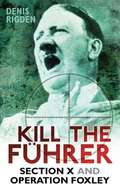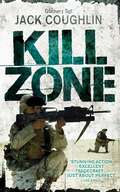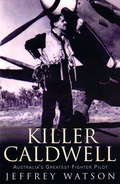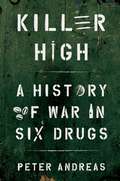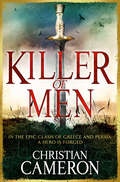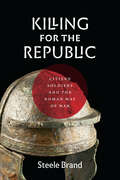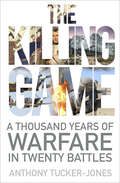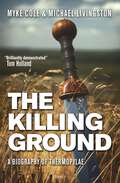- Table View
- List View
Kill Hitler: Operation Valkyrie 1944 (Raid #40)
by Peter Dennis Mark Stacey Neil ShortAlthough far from a typical raid, the 20 July Plot – Operation Valkyrie – was still a daring and audacious attack undertaken by a small, very brave, group of individuals, determined to kill Hitler. Hitler was badly shaken by the blast and, despite the fact that numerous other attempts had been made on the Führer's life since he came to power, the July 20 Plot has achieved an almost mythic status. Numerous books, both factual and fictional, have been written on the subject. There have been several TV dramatisations and reconstructions, including a MythBusters production which considered whether or not the attempt would have been successful if the bomb had been planted in Hitler's bunker. German resistance to Hitler has also been depicted on film, most notably by James Mason in The Desert Fox and more recently by Tom Cruise in Valkyrie, an accurate and acclaimed version of the July 20 Plot.
Kill Hitler: Operation Valkyrie 1944 (Raid #40)
by Neil ShortAlthough far from a typical raid, the 20 July Plot – Operation Valkyrie – was still a daring and audacious attack undertaken by a small, very brave, group of individuals, determined to kill Hitler. Hitler was badly shaken by the blast and, despite the fact that numerous other attempts had been made on the Führer's life since he came to power, the July 20 Plot has achieved an almost mythic status. Numerous books, both factual and fictional, have been written on the subject. There have been several TV dramatisations and reconstructions, including a MythBusters production which considered whether or not the attempt would have been successful if the bomb had been planted in Hitler's bunker. German resistance to Hitler has also been depicted on film, most notably by James Mason in The Desert Fox and more recently by Tom Cruise in Valkyrie, an accurate and acclaimed version of the July 20 Plot.
A Kill in the Morning
by Graeme Shimmin‘I don’t like killing, but I’m good at it. Murder isn’t so bad from a distance, just shapes popping up in my scope. Close-up work though – a garrotte around a target’s neck or a knife in their heart – it’s not for me. Too much empathy, that’s my problem. Usually. But not today. Today is different . . . ‘The year is 1955 and something is very wrong with the world. It is fourteen years since Churchill died and the Second World War ended. In occupied Europe, Britain fights a cold war against a nuclear-armed Nazi Germany.In Berlin the Gestapo is on the trail of a beautiful young resistance fighter, and the head of the SS is plotting to dispose of an ailing Adolf Hitler and restart the war against Britain and her empire. Meanwhile, in a secret bunker hidden deep beneath the German countryside, scientists are experimenting with a force far beyond their understanding.Into this arena steps a nameless British assassin, on the run from a sinister cabal within his own government, and planning a private war against the Nazis. And now the fate of the world rests on a single kill in the morning . . .
Kill Rommel!: Operation Flipper 1941 (Raid)
by Gavin Mortimer Peter Dennis Johnny Shumate Alan GillilandIn November 1941, a small party of British Commandos landed by submarine in Libya, tasked with the assassination of General Erwin Rommel, commander of the German forces in North Africa, who was believed to be staying in a villa near the coast. Three men – Lt-Col Geoffrey Keyes, Capt Robin Campbell and Sgt Jack Terry – stormed the villa, but the German general was nowhere to be found. In the confused fighting Keyes was killed and Campbell wounded; only two raiders would escape, one of whom was Terry. The raid made headlines round the free world, and Keyes was awarded a posthumous Victoria Cross. Yet in truth the raid had been a glorious failure, a mission bedevilled by bad planning and poor intelligence. Even so, crucial lessons were learned, particularly by the Special Air Service – who carried out their first mission on the same night as the raid on Rommel's HQ.
Kill Rommel!: Operation Flipper 1941 (Raid #43)
by Gavin Mortimer Peter Dennis Johnny Shumate Alan GillilandIn November 1941, a small party of British Commandos landed by submarine in Libya, tasked with the assassination of General Erwin Rommel, commander of the German forces in North Africa, who was believed to be staying in a villa near the coast. Three men – Lt-Col Geoffrey Keyes, Capt Robin Campbell and Sgt Jack Terry – stormed the villa, but the German general was nowhere to be found. In the confused fighting Keyes was killed and Campbell wounded; only two raiders would escape, one of whom was Terry. The raid made headlines round the free world, and Keyes was awarded a posthumous Victoria Cross. Yet in truth the raid had been a glorious failure, a mission bedevilled by bad planning and poor intelligence. Even so, crucial lessons were learned, particularly by the Special Air Service – who carried out their first mission on the same night as the raid on Rommel's HQ.
Kill the Fuhrer: Section X and Operation Foxley
by Denis RigdenDuring the Second World War, Britain's top secret Special Operations Executive plotted to assassinate Hitler. A small department of SOE known as Section X had the tantalisingly complext task of investigating how, when and where their plan could be executed. The section also plotted the killing of Goebbels, Himmler and other selected members of Hitler's inner circle. Only Section X and a handful of other SOE staff had any knowledge of these projects, codenamed Operatino Foxley and Operation Little Foxleys. As history has shown, these schemes turned out to be pipe dreams. Even so, Section X, renamed the German Directorate in 1944, made a huge contribution to the Allied war effort through their organised sabotage and clandestine distribution of black propaganda. Denis Rigden describes Section X's efforts to discover as much as possible about the intended assassination targets, and questions whether a successful Operation Foxley would have helped or hindered the Allied cause. Based on top secret documents and private sources and illustrated with archive photographs, 'Kill the Fuhrer' is an intriguing insight into the shadowy world of Britain's wartime secret services.
Kill Them All: Cathars and Carnage in the Albigensian Crusade
by Sean McGlynnThe Albigensian crusade 1209-1229) by the Catholic Church against the Cathar heretics of southern France is infamous for its brutality. Marked by massacres and acts of appalling cruelty, these deeds are commonly ascribed to the role of religious fanaticism. This book is the first to offer a dedicated military history of the whole Crusade; in so doing it refutes this old view. By telling the story of the Crusade through its dramatic sieges, battles and campaigns and offering expert analysis of the warfare involved, the author reveals the Crusade in a new light – as a bloody territorial conquest in which acts of terror were perpetrated to secure military aims rather than religious ones. The result is an exciting and at times disturbing book that tells the dramatic military events of the Crusade and its leading characters – Simon de Montfort, Louis the Lion, Innocent III, Peter of Aragon, Count Raymond of Toulouse - through the voices of those contemporary writers who fought it and experienced it.
Kill Zone (Gunnery Sergeant Kyle Swanson series #1)
by Jack Coughlin Donald A. DavisAn American general is captured in the Middle East by terrorists who threaten to behead him. But moments before he is rendered unconscious, the general notices that his captors speak American English. What’s going on? Gunnery-Sergeant Kyle Swanson is vacationing in the Mediterranean when he receives orders to mount a top-secret mission to rescue the general. But as the Marines prepare to land in the desert, they fall victim to a terrible accident. Swanson, the only survivor, then discovers they were flying into a deliberate ambush. But how could the enemy have details of a mission known only to a few top US government officials? Swanson takes off alone to locate the captured general and realizes he is fighting a particularly ruthless enemy: American mercenaries working for a very high-level group within the White House, whose hidden goal is total control of the US military. The fate of the captured general and that of the nation now rest solely in Swanson’s hands. 'Stunning action, excellent tradecraft, insider politics, and the ring of truth. Just about perfect' Lee Child
The Kill Zone: A blood pumping thriller
by Chris RyanFrom the author of the bestselling Danny Black series and the hit TV show Strikeback.The guys in the Regiment know they face their fiercest enemies when they fight the Taliban. No-one is tougher, more deadly - or more cunning. And if they enter the Taliban's kill zone, they know just what to expect...When three deadly Stinger missiles go missing in Helmand Province, the Regiment is tasked to retrieve the weapons at all costs. SAS legend Jack Harker has a mission to lead an eight-man team into a suspected Taliban facility. He's suspicious about what the aims of the mission really are - and it's about to get noisy.Meanwhile, in Belfast, Siobhan Byrne, a highly trained surveillance operative, is infiltrating the drug crew of a former IRA commander. But are her motives professional or personal? Even she doesn't know any more.Neither Jack nor Siobhan can guess just how closely linked their operations are about to become, or just what's at stake. But as the President of the United States makes plans to visit the UK, a devastating plot unfolds.
Killer Caldwell: Australia’s Greatest Fighter Pilot (Hachette Military Collection)
by Jeffrey WatsonClive 'Killer' Caldwell was a natural and brilliant pilot, a superb shot, and a born leader. He saw action against the Germans, Italians and Japanese, and remains Australia's greatest ever fighter pilot.Born and brought up in Sydney, it was obvious from an early age that nothing would stand in Caldwell's way. He bluffed his way into the RAAF, then made sure that he was posted to exactly where he thought he should be.His ability was unquestioned by all those around him, and he devised the vital 'shadow shooting' technique which contributed so much to Allied success in the air in the north African campaign, and in northern Australia. But he was never afraid of voicing his opinions to all those above and below him, be it about the training of pilots, or the equipping of Spitfires for use against the Japanese - and for trying to run the show his way...Caldwell ended his military career in the Morotai Mutiny in 1945, where he and a number of other Australian pilots tried to resign their commisions in protest at not being allowed by General MacArthur - and the RAAF - to take part in the main action. And then he was embroiled in the Barry inquiry into booze smuggling by him and other pilots...Killer Caldwell is a colourful portrait of a colourful Australian.
Killer High: A History of War in Six Drugs
by Peter AndreasThere is growing alarm over how drugs empower terrorists, insurgents, militias, and gangs. But by looking back not just years and decades but centuries, Peter Andreas reveals that the drugs-conflict nexus is actually an old story, and that powerful states have been its biggest beneficiaries. In his path-breaking Killer High, Andreas shows how six psychoactive drugs-ranging from old to relatively new, mild to potent, licit to illicit, natural to synthetic-have proven to be particularly important war ingredients. This sweeping history tells the story of war from antiquity to the modern age through the lens of alcohol, tobacco, caffeine, opium, amphetamines, and cocaine. Beer and wine drenched ancient and medieval battlefields, and the distilling revolution lubricated the conquest and ethnic cleansing of the New World. Tobacco became globalized through soldiering, with soldiers hooked on smoking and governments hooked on taxing it. Caffeine and opium fueled imperial expansion and warfare. The commercialization of amphetamines in the twentieth century energized soldiers to fight harder, longer, and faster, while cocaine stimulated an increasingly militarized drug war that produced casualty numbers surpassing most civil wars. As Andreas demonstrates, armed conflict has become progressively more drugged with the introduction, mass production, and global spread of mind-altering substances. As a result, we cannot understand the history of war without including drugs, and we similarly cannot understand the history of drugs without including war. From ancient brews and battles to meth and modern warfare, drugs and war have grown up together and become addicted to each other.
Killer High: A History of War in Six Drugs
by Peter AndreasThere is growing alarm over how drugs empower terrorists, insurgents, militias, and gangs. But by looking back not just years and decades but centuries, Peter Andreas reveals that the drugs-conflict nexus is actually an old story, and that powerful states have been its biggest beneficiaries. In his path-breaking Killer High, Andreas shows how six psychoactive drugs-ranging from old to relatively new, mild to potent, licit to illicit, natural to synthetic-have proven to be particularly important war ingredients. This sweeping history tells the story of war from antiquity to the modern age through the lens of alcohol, tobacco, caffeine, opium, amphetamines, and cocaine. Beer and wine drenched ancient and medieval battlefields, and the distilling revolution lubricated the conquest and ethnic cleansing of the New World. Tobacco became globalized through soldiering, with soldiers hooked on smoking and governments hooked on taxing it. Caffeine and opium fueled imperial expansion and warfare. The commercialization of amphetamines in the twentieth century energized soldiers to fight harder, longer, and faster, while cocaine stimulated an increasingly militarized drug war that produced casualty numbers surpassing most civil wars. As Andreas demonstrates, armed conflict has become progressively more drugged with the introduction, mass production, and global spread of mind-altering substances. As a result, we cannot understand the history of war without including drugs, and we similarly cannot understand the history of drugs without including war. From ancient brews and battles to meth and modern warfare, drugs and war have grown up together and become addicted to each other.
Killer in the Kremlin: The instant bestseller - a gripping and explosive account of Vladimir Putin's tyranny
by John SweeneyA gripping and explosive account of Vladimir Putin's tyranny, charting his rise from spy to tsar, exposing the events that led to his invasion of Ukraine and his assault on Europe.In Killer in the Kremlin, award-winning journalist John Sweeney takes readers from the heart of Putin's Russia to the killing fields of Chechnya, to the embattled cities of an invaded Ukraine.In a disturbing exposé of Putin's sinister ambition, Sweeney draws on thirty years of his own reporting - from the Moscow apartment bombings to the atrocities committed by the Russian Army in Chechnya, to the annexation of Crimea and a confrontation with Putin over the shooting down of flight MH17 - to understand the true extent of Putin's long war.Drawing on eyewitness accounts and compelling testimony from those who have suffered at Putin's hand, we see the heroism of the Russian opposition, the bravery of the Ukrainian resistance, and the brutality with which the Kremlin responds to such acts of defiance, assassinating or locking away its critics, and stopping at nothing to achieve its imperialist aims.In the midst of one of the darkest acts of aggression in modern history - Russia's invasion of Ukraine - this book shines a light on Putin's rule and poses urgent questions about how the world must respond.
Killer of Men (The Long War #1)
by Christian CameronIn the epic clash of Greece and Persia, a hero is forged - a monumental novel from the author of the Tyrant series.Arimnestos is a farm boy when war breaks out between the citizens of his native Plataea and their overbearing neighbours, Thebes. Standing in the battle line for the first time, alongside his father and brother, he shares in a famous and unlikely victory. But after being knocked unconscious in the melee, he awakes not a hero, but a slave.Betrayed by his jealous and cowardly cousin, the freedom he fought for has now vanished, and he becomes the property of a rich citizen. So begins an epic journey out of slavery that takes the young Arimnestos through a world poised on the brink of an epic confrontation, as the emerging civilization of the Greeks starts to flex its muscles against the established empire of the Persians. As he tries to make his fortune and revenge himself on the man who disinherited him, Arimnestos discovers that he has a talent that pays well in this new, violent world - for like his hero, Achilles, he is 'a killer of men'.
Killing Bin Laden: Operation Neptune Spear 2011 (Raid)
by Peter PanzeriOn May 2, 2011 a ten-year manhunt drew to a deadly end as the men of the US Naval Special Warfare Development Group (a.k.a. SEAL Team Six) closed in on their prey, Osama Bin Laden, the mastermind of the World Trade Center attack on September 11, 2001. Flown from Afghanistan by Army Special Operations Command's 160th Special Operations Aviation Regiment (Airborne) and evading detection by the Pakistani military, two US helicopters flew towards the compound where they believed Bin Laden to be. Forty minutes later one helicopter had crashed and five people were dead, including the al-Qaeda leader. In this book the story of the raid is told, from start to finish, using specially commissioned full-colour artwork, photographs, and maps. The operation, codenamed Neptune Spear, is expertly analyzed and the events are told in a concise and clear account of its build-up, execution, and aftermath, demonstrating the skill and courage of the men who carried it out.
Killing Bin Laden: Operation Neptune Spear 2011 (Raid)
by Johnny Shumate Peter PanzeriOn May 2, 2011 a ten-year manhunt drew to a deadly end as the men of the US Naval Special Warfare Development Group (a.k.a. SEAL Team Six) closed in on their prey, Osama Bin Laden, the mastermind of the World Trade Center attack on September 11, 2001. Flown from Afghanistan by Army Special Operations Command's 160th Special Operations Aviation Regiment (Airborne) and evading detection by the Pakistani military, two US helicopters flew towards the compound where they believed Bin Laden to be. Forty minutes later one helicopter had crashed and five people were dead, including the al-Qaeda leader. In this book the story of the raid is told, from start to finish, using specially commissioned full-colour artwork, photographs, and maps. The operation, codenamed Neptune Spear, is expertly analyzed and the events are told in a concise and clear account of its build-up, execution, and aftermath, demonstrating the skill and courage of the men who carried it out.
Killing for the Company: Just another day at the office...
by Chris RyanFrom the author of the bestselling Danny Black series and hit TV show Strikeback. Former SAS legend Chris Ryan brings you his sixteenth novel and it is full of all his trademark action, thrills and inside knowledge.2003. Invalided out of the SAS Chet Freeman makes his living in high-end security, on a temporary contract for an American corporation called the Grosvenor Group. He catches a young woman, a peace campaigner, eavesdropping on a meeting the Group is holding with the British Prime Minister. The Group's interests include arms manufacture, and what Chet and the young woman overhear seems to imply that it is bribing the Prime Minister to take his country into an illegal war. Could this possibly be true? Somebody believes that this is a secret that needs covering up, because Chet and the girl are attacked. Hunted down, they go into hiding, and a deadly game of cat and mouse begins.Nearly ten years later tension is reaching breaking point in Jerusalem. The now ex-Prime Minister is working as a Middle East peace envoy. As the city descends into anarchy and rival armies are poised to turn it into a battlefield, Chet's best buddy, Luke, is part of a team tasked by the Regiment with extracting the ex-Prime Minister.At the height of the battle Luke discovers a conspiracy far more devastating than any arms deal.
Killing for the Republic: Citizen-Soldiers and the Roman Way of War
by Steele Brand"For who is so worthless or indolent as not to wish to know by what means and under what system of polity the Romans... succeeded in subjecting nearly the whole inhabited world to their sole government—a thing unique in history?"—PolybiusThe year 146 BC marked the brutal end to the Roman Republic's 118-year struggle for the western Mediterranean. Breaching the walls of their great enemy, Carthage, Roman troops slaughtered countless citizens, enslaved those who survived, and leveled the 700-year-old city. That same year in the east, Rome destroyed Corinth and subdued Greece. Over little more than a century, Rome's triumphant armies of citizen-soldiers had shocked the world by conquering all of its neighbors. How did armies made up of citizen-soldiers manage to pull off such a major triumph? And what made the republic so powerful? In Killing for the Republic, Steele Brand explains how Rome transformed average farmers into ambitious killers capable of conquering the entire Mediterranean. Rome instilled something violent and vicious in its soldiers, making them more effective than other empire builders. Unlike the Assyrians, Persians, and Macedonians, it fought with part-timers. Examining the relationship between the republican spirit and the citizen-soldier, Brand argues that Roman republican values and institutions prepared common men for the rigors and horrors of war. Brand reconstructs five separate battles—representative moments in Rome's constitutional and cultural evolution that saw its citizen-soldiers encounter the best warriors of the day, from marauding Gauls and the Alps-crossing Hannibal to the heirs of Alexander the Great. A sweeping political and cultural history, Killing for the Republic closes with a compelling argument in favor of resurrecting the citizen-soldier ideal in modern America.
Killing for the Republic: Citizen-Soldiers and the Roman Way of War
by Steele Brand"For who is so worthless or indolent as not to wish to know by what means and under what system of polity the Romans... succeeded in subjecting nearly the whole inhabited world to their sole government—a thing unique in history?"—PolybiusThe year 146 BC marked the brutal end to the Roman Republic's 118-year struggle for the western Mediterranean. Breaching the walls of their great enemy, Carthage, Roman troops slaughtered countless citizens, enslaved those who survived, and leveled the 700-year-old city. That same year in the east, Rome destroyed Corinth and subdued Greece. Over little more than a century, Rome's triumphant armies of citizen-soldiers had shocked the world by conquering all of its neighbors. How did armies made up of citizen-soldiers manage to pull off such a major triumph? And what made the republic so powerful? In Killing for the Republic, Steele Brand explains how Rome transformed average farmers into ambitious killers capable of conquering the entire Mediterranean. Rome instilled something violent and vicious in its soldiers, making them more effective than other empire builders. Unlike the Assyrians, Persians, and Macedonians, it fought with part-timers. Examining the relationship between the republican spirit and the citizen-soldier, Brand argues that Roman republican values and institutions prepared common men for the rigors and horrors of war. Brand reconstructs five separate battles—representative moments in Rome's constitutional and cultural evolution that saw its citizen-soldiers encounter the best warriors of the day, from marauding Gauls and the Alps-crossing Hannibal to the heirs of Alexander the Great. A sweeping political and cultural history, Killing for the Republic closes with a compelling argument in favor of resurrecting the citizen-soldier ideal in modern America.
The Killing Game: A Thousand Years of Warfare in Twenty Battles
by Anthony Tucker-JonesThe second millennium of mankind has been characterized by almost incessant warfare somewhere on the face of the globe. The Killing Game serves as a snapshot of the development of warfare over the past 1,000 years, illustrating the bravery and suffering mankind has inflicted upon itself in developing what we call the ‘Art of War’. Here military historian Anthony Tucker-Jones selects twenty battles that illustrate the changing face of warfare over the past thousand years – from the Viking shield wall to long bows and knights, the emergence of gunpowder and finally the long-range faceless warfare of today. This is a look at the killing game and its devastating impact.
The Killing Ground: A Biography of Thermopylae
by Myke Cole Dr Michael LivingstonAn exploration into why and how Thermopylae is one of the most blood-soaked patches of ground in history – and what its past can tell us about our future.'Brilliantly demonstrated.' - Tom HollandSince the dawn of the Classical Era up to World War II, thousands have lost their lives fighting over the pass at Thermopylae. Historians Cole and Livingston provide an exciting account of each of the 27 battles and holding actions that took place. The epic events of 480 BC when 300 Spartans attempted to hold the pass has been immortalised in poetry, art, literature and film. But no history has ever detailed the other events from the very first battle through to the battles fought by Romans, Byzantines, Huns and Ottomans during the early and late medieval periods and finally the two desperate struggles against German occupying forces during World War II. The Killing Ground details the background and history of each conflict, the personalities and decision making of the commanders, the arms and tactics of the troops, and how each battle played out. Cole and Livingston have surveyed the ground to provide a boots-on understanding of each battle. Their command of multiple ancient and medieval languages means they have provided their own translations of much of the source material, ensuring new insights into each battle. This uncompromising scholarship is woven together into a compelling and unforgettable history that grips the reader from start to finish.
The Killing Ground: A Biography of Thermopylae
by Myke Cole Dr Michael LivingstonAn exploration into why and how Thermopylae is one of the most blood-soaked patches of ground in history – and what its past can tell us about our future.'Brilliantly demonstrated.' - Tom HollandSince the dawn of the Classical Era up to World War II, thousands have lost their lives fighting over the pass at Thermopylae. Historians Cole and Livingston provide an exciting account of each of the 27 battles and holding actions that took place. The epic events of 480 BC when 300 Spartans attempted to hold the pass has been immortalised in poetry, art, literature and film. But no history has ever detailed the other events from the very first battle through to the battles fought by Romans, Byzantines, Huns and Ottomans during the early and late medieval periods and finally the two desperate struggles against German occupying forces during World War II. The Killing Ground details the background and history of each conflict, the personalities and decision making of the commanders, the arms and tactics of the troops, and how each battle played out. Cole and Livingston have surveyed the ground to provide a boots-on understanding of each battle. Their command of multiple ancient and medieval languages means they have provided their own translations of much of the source material, ensuring new insights into each battle. This uncompromising scholarship is woven together into a compelling and unforgettable history that grips the reader from start to finish.
Killing Ground
by Don PendletonMack Bolan is on a covert mission in Afghanistan when the body of an American soldier goes missing following an ambush. Bolan is determined to get the fallen soldier back on American soil, but the Taliban forces who stole the body have their own plans–and an honorable burial is not one of them.
Killing Ground: a no-holds-barred tale of naval warfare from Douglas Reeman, the all-time bestselling master of storyteller of the sea
by Douglas ReemanThe Western Ocean 1942. From the bridge of HMS Gladiator, Lieutenant-Commander David Howard's orders were chillingly clear. There could be no mercy.To the men who fought to protect the vital, threatened Merchat Navy convoys in the Western Approaches, the Battle of the Atlantic was a full-scale war.A relentless, savage war against an ever-present enemy and a violent sea - in an arena known only to its embittered survivors as the killing ground.HMS Gladiator was part of that war. An ordinary, hard-worked destroyer and her company of men. Fighting for survival in a war with no rules...





